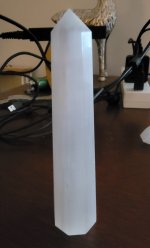- Joined
- Jul 9, 2015
- Messages
- 261
- Points
- 43
Wanted to see how my phone camera would do with taking some photos. I illuminated a satin spar obelisk with some of my lasers here are the results:
The obelisk:

650nm:

445nm:

650nm + 445nm:

532nm:

532nm + 445nm:

532nm + 650nm:

589nm:

589nm + 445nm:

589nm + 532nm:

I did try both 589nm and 650nm together but the camera didn't seem to capture any change between just the 589nm alone. To my eyes it got ever so slightly deeper orange. The way this was carried out was I illuminated the obelisk at the base and when two lasers were used I overlapped the beam spots on top of each other. Anyway, I enjoyed this little exercise, have a great day everyone!
The obelisk:

650nm:

445nm:

650nm + 445nm:

532nm:

532nm + 445nm:

532nm + 650nm:

589nm:

589nm + 445nm:

589nm + 532nm:

I did try both 589nm and 650nm together but the camera didn't seem to capture any change between just the 589nm alone. To my eyes it got ever so slightly deeper orange. The way this was carried out was I illuminated the obelisk at the base and when two lasers were used I overlapped the beam spots on top of each other. Anyway, I enjoyed this little exercise, have a great day everyone!











